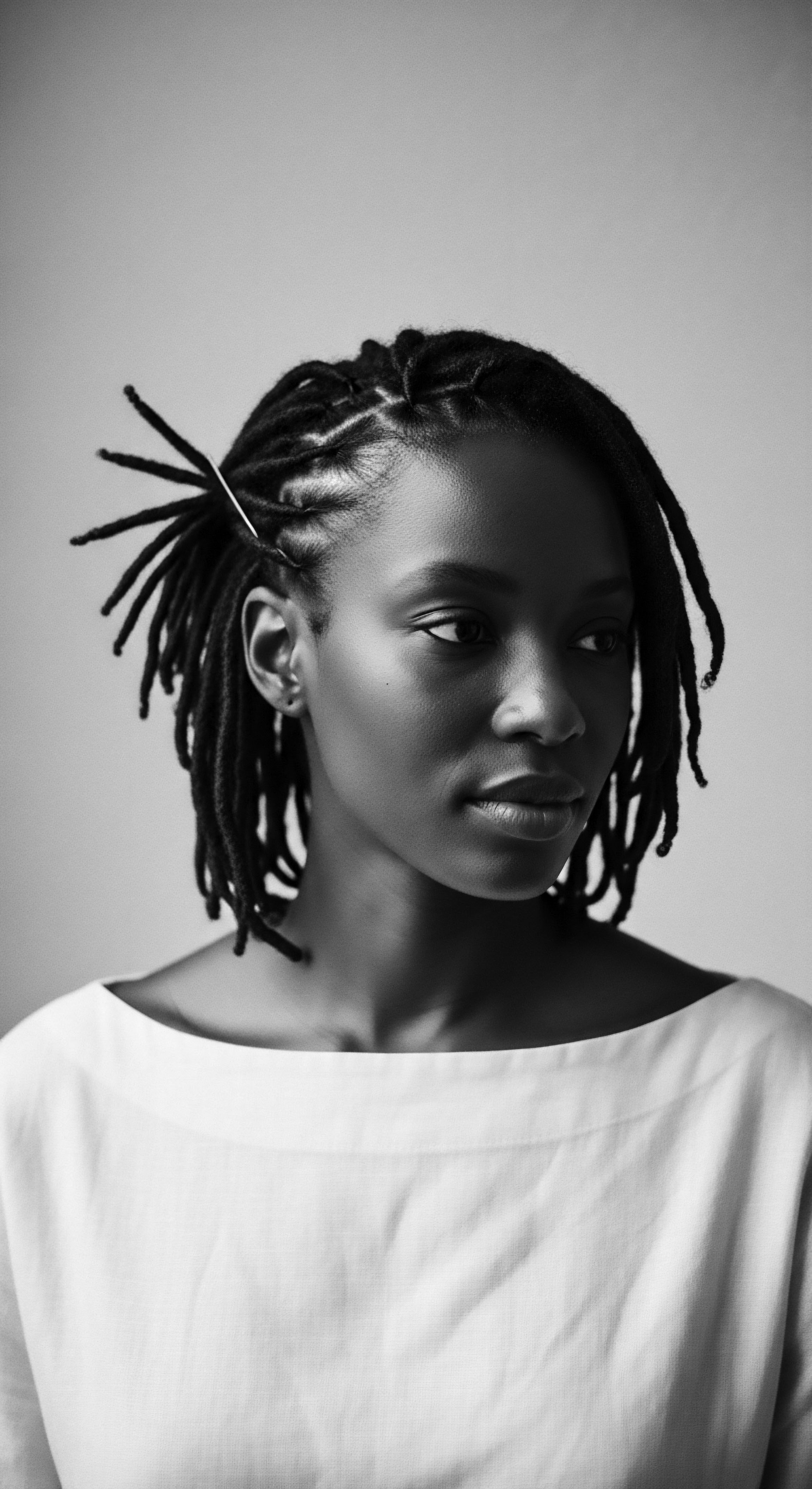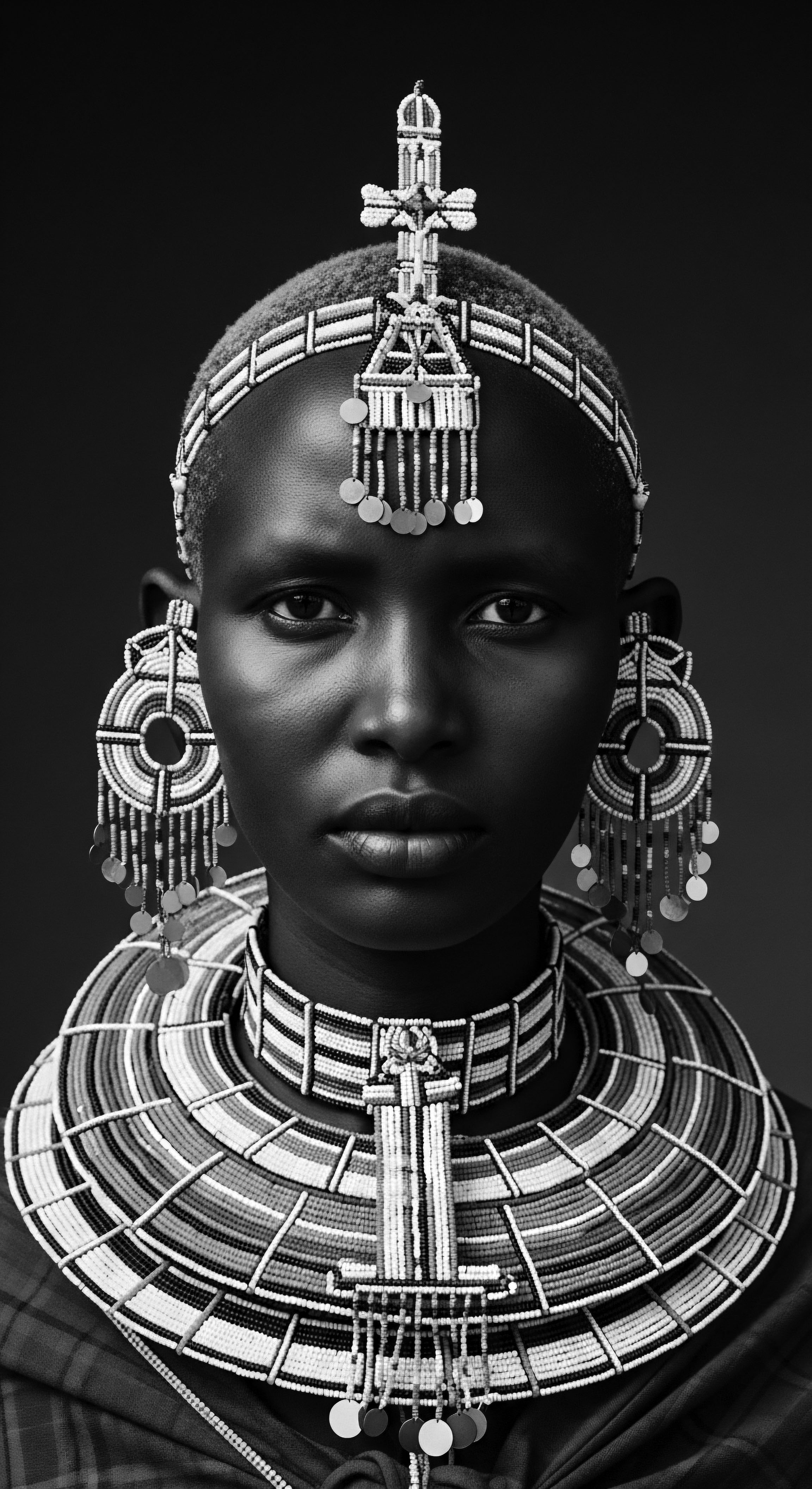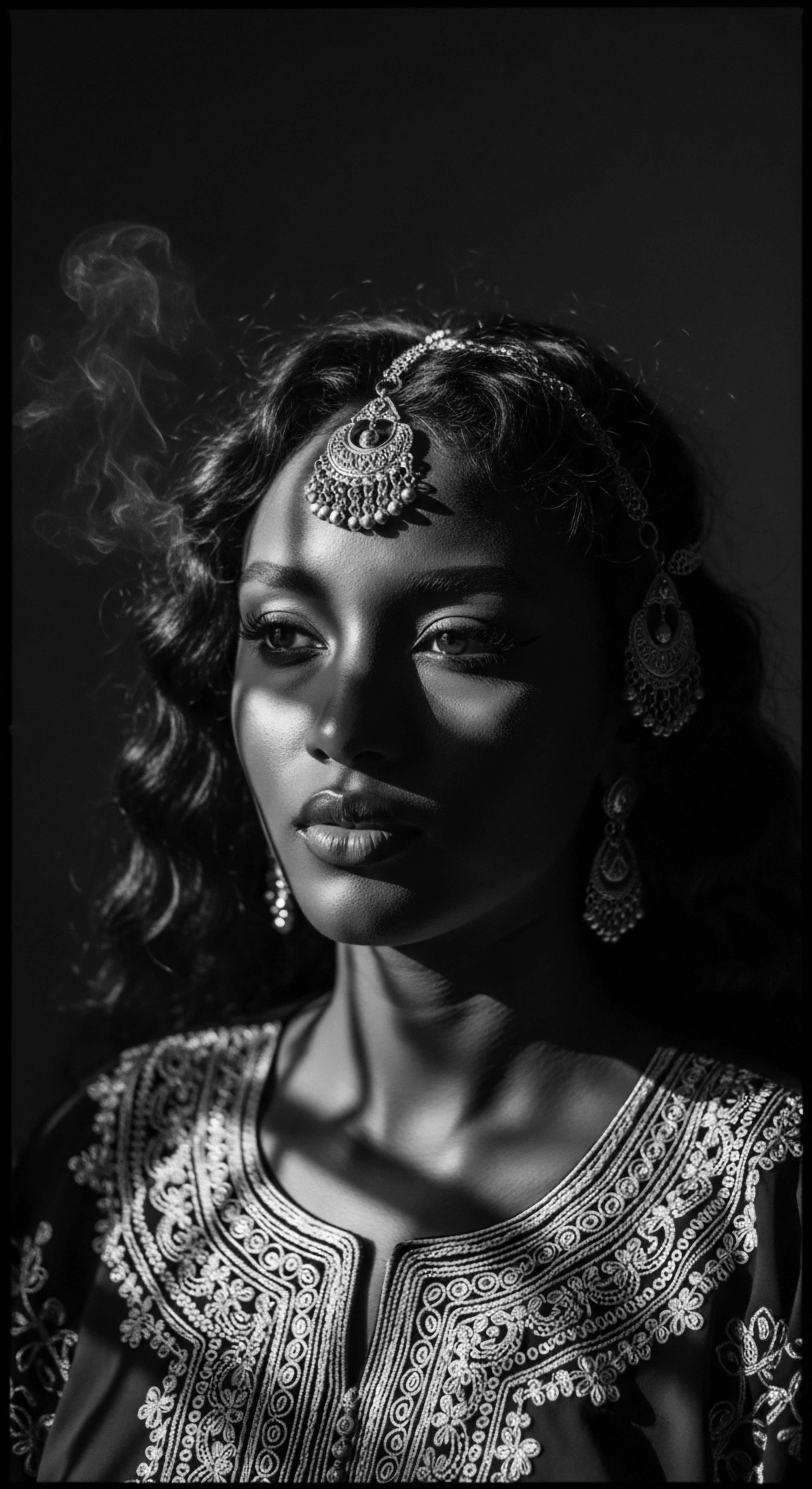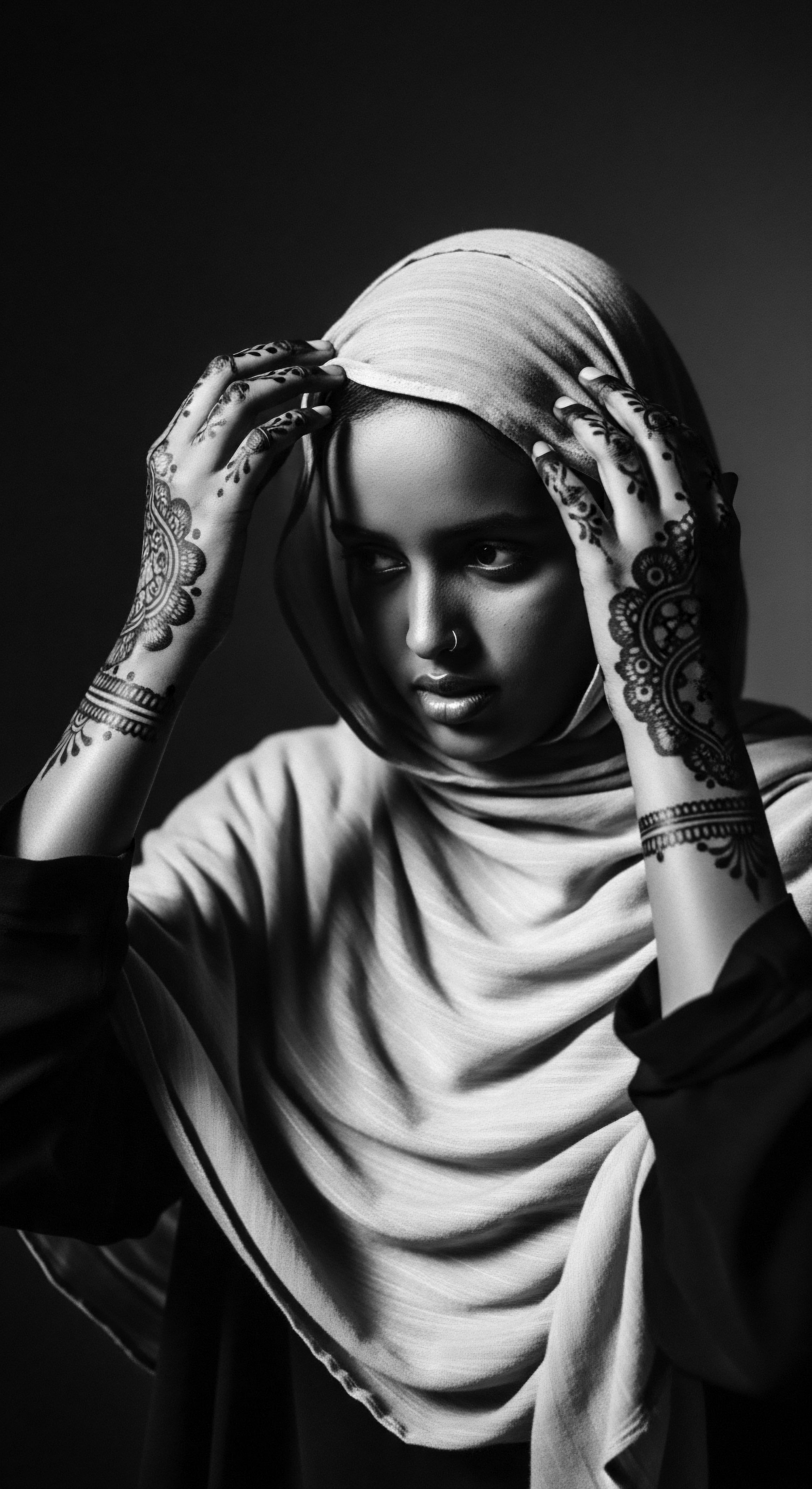
Fundamentals
The concept of African Societies, when viewed through the lens of Roothea’s ‘living library’ and its dedication to Textured Hair Heritage, transcends mere geographical or political groupings. It instead signifies the profound, interwoven legacy of diverse communities across the African continent, whose very understanding of self, community, and the spiritual realm was, and often remains, intrinsically linked to the hair adorning their crowns. This fundamental understanding is not simply a historical fact; it is a vibrant, continuing narrative.
Hair in these societies was never merely an aesthetic choice. It functioned as a living, breathing language, a silent yet potent communicator of identity and belonging. The varied textures, from tightly coiled strands to more loosely curled patterns, were celebrated as natural expressions of beauty and heritage. Each twist, braid, or adornment held a story, a message understood within the community.
African Societies, in the context of textured hair heritage, represent a rich tapestry of cultural meanings and practices where hair serves as a profound expression of identity and community.
This foundational perspective invites us to look beyond superficial appearances and truly perceive hair as a cherished element of human experience, a testament to ancestral wisdom. The care rituals, the communal gatherings for styling, and the symbolic significance of hair all point to a deeply integrated system of cultural meaning.

The Crown as a Communal Canvas
In ancient African societies, the head was often considered the most elevated part of the body, a sacred space. This belief positioned hair as a direct conduit to the divine, a portal for spiritual energy and communication with ancestors. Such a profound connection meant that hair care was far from a solitary act; it was a communal ritual, strengthening bonds and transmitting generational knowledge.
The hands that tended to one’s hair were often those of trusted family members or skilled community stylists, reinforcing ties of affection and shared heritage. This collective approach to grooming fostered social cohesion, allowing for the exchange of stories, wisdom, and laughter, solidifying the communal fabric.
The intricate styles themselves, which could take hours or even days to create, were a testament to patience, artistry, and shared time. These sessions were not simply about achieving a desired look; they were moments of connection, a tender thread woven through daily life, binding individuals to their lineage and their present community. The very act of caring for hair became a ceremonial practice, imbued with respect for the past and hope for the future.

Intermediate
Moving beyond the foundational appreciation, an intermediate understanding of African Societies and their textured hair heritage requires a deeper exploration of the nuanced ways hair conveyed intricate societal messages. Before the profound disruptions of colonial incursions, hair served as a sophisticated visual lexicon, allowing individuals to communicate a wealth of information without uttering a single word. This silent language was universally understood within specific cultural contexts, revealing a person’s life journey, affiliations, and standing.
The varied textures inherent to African hair were not merely accepted but celebrated, forming the very basis for a myriad of styles. These styles were not arbitrary but rather codified expressions, each pattern, each adornment, carrying a specific weight of meaning. From the West African nations of the Yoruba, Mende, and Wolof to the Himba of Namibia, hair conveyed marital status, age, religious beliefs, ethnic identity, and even wealth or communal rank. This deep integration of hair into social structures underscores its unparalleled significance.
Pre-colonial African hair practices were sophisticated systems of non-verbal communication, with styles signifying everything from social status and age to spiritual beliefs and tribal affiliation.

The Language of Braids and Adornments
The artistry of African hair braiding, which dates back thousands of years, is a testament to both creativity and function. Cornrows, for instance, a style traced back to 3500 BCE in the Sahara desert, were not only practical for managing hair in demanding climates but also served as a medium for complex communication. The direction of the braids, the tightness of the weave, and the inclusion of beads, cowrie shells, or other natural materials could denote specific tribal affiliations, a woman’s readiness for marriage, or even a period of mourning.
Consider the Himba tribe of Northwestern Namibia, where hair styling remains a powerful indicator of age, life stage, and marital status. Young girls wear braid strands or dreadlocked hair that hangs over their faces, symbolizing their entry into puberty. Married women and new mothers don distinctive Erembe headdresses made from animal skin, while young women prepared for marriage tie their dreadlocks to reveal their faces. This precise use of hair as a marker highlights a deep, inherited wisdom about visual identity.
Beyond braids, the incorporation of natural oils, butters, and herbs into hair care rituals speaks to a profound understanding of elemental biology and holistic wellbeing. Ingredients such as Shea Butter, Marula Oil, and Aloe Vera were not merely moisturizers; they were integral to maintaining hair health, offering protection from environmental elements, and nourishing the scalp. These practices were passed down through generations, forming a living library of traditional care that sustained hair vitality and beauty.
The meticulous processes involved in traditional African hair care, often spanning hours or days, were not seen as burdens. Instead, they were opportunities for intergenerational bonding, storytelling, and the reinforcement of cultural values. These shared moments fostered a sense of belonging and continuity, where the hands of a mother, aunt, or elder stylist became conduits for transmitting ancestral knowledge and love.
- Cornrows ❉ A style with origins dating back thousands of years, serving as both a practical hair management solution and a sophisticated means of non-verbal communication, often used to convey messages or identify tribal affiliation.
- Dreadlocks ❉ Worn by various groups, including the Himba and Maasai, symbolizing spiritual connection, life stages, and social standing, often enhanced with natural pigments and materials.
- Bantu Knots ❉ Traced to the Bantu-speaking communities of the 2nd millennium BCE, these coiled knots held cultural and aesthetic significance, representing a traditional and protective style.
| Hair Practice/Style Intricate Braids |
| Associated Cultural Meanings Social status, marital status, age, tribal identity, spiritual beliefs. |
| Geographic/Tribal Context (Examples) Yoruba, Wolof, Mende, Fulani (West Africa) |
| Hair Practice/Style Dreadlocks with Ochre |
| Associated Cultural Meanings Life stage, age, marital status, connection to earth and ancestors. |
| Geographic/Tribal Context (Examples) Himba (Namibia) |
| Hair Practice/Style Shaved Heads (Partial/Full) |
| Associated Cultural Meanings Mourning, passage into adulthood, spiritual cleansing, readiness for war. |
| Geographic/Tribal Context (Examples) Wolof (Senegal), Maasai (East Africa), Nguni (South Africa) |
| Hair Practice/Style Headwraps |
| Associated Cultural Meanings Dignity, resilience, protection, modesty, cultural identity. |
| Geographic/Tribal Context (Examples) Various African and diasporic communities, especially during slavery. |
| Hair Practice/Style These practices highlight the deep, inherent meaning woven into every strand of textured hair across African societies. |

Academic
The academic definition of African Societies, particularly as it pertains to textured hair heritage, delineates a complex interplay of biology, socio-cultural construction, and historical resilience. It is an elucidation that recognizes hair not merely as a biological appendage, but as a dynamic cultural artifact, a potent symbol of identity, and a profound repository of ancestral knowledge. This scholarly interpretation posits that the diverse hair practices across African civilizations constitute an enduring testament to human adaptability, artistic expression, and resistance against subjugation. The meaning of “African Societies” in this context is therefore a nuanced statement of collective cultural self-determination, continually reaffirmed through the very fibers of textured hair.
At its core, this understanding rests upon the biological distinctiveness of textured hair, characterized by its elliptical follicle shape, tighter curl patterns, and varied density, which contribute to its unique volumetric and styling capabilities. This biological foundation, however, gains its profound significance through its interpretation and application within various African cultural matrices. Hair was revered as the most elevated part of the human form, often believed to be a conduit for spiritual communication and a source of personal power. The maintenance of hair was thus a sacred duty, performed with intention and often through communal engagement, reinforcing social cohesion and transmitting cultural norms across generations.

Echoes from the Source ❉ Hair as a Biological and Spiritual Nexus
From ancient Egypt, where elaborate wigs and braided styles signified social status and religious devotion, to the Kingdom of Kush and various West African cultures, archaeological evidence consistently reveals hair as an expression of power, spirituality, and social cohesion. The Yoruba people of Nigeria, for instance, held hair as the most elevated part of the body, utilizing braided patterns to send messages to deities. This perspective underscores a profound pre-colonial epistemology where the physical realm of hair was inseparable from the metaphysical.
The very act of hair styling, often performed by skilled artisans or trusted kin, was a ritualistic process, not merely a cosmetic one. This communal grooming, spanning hours or even days, became a vital social activity, a space for intergenerational dialogue, storytelling, and the reinforcement of familial and communal bonds. It was within these intimate settings that the practical knowledge of hair care, including the application of natural ingredients like Shea Butter, Marula Oil, Aloe Vera, and various clays, was meticulously passed down. These substances, rooted in indigenous ethnobotanical wisdom, provided essential nourishment, protection, and therapeutic benefits for textured hair, validating ancestral practices through their enduring efficacy.
A compelling example of this profound connection between hair, identity, and ancestral practice can be observed in the history of hair during the transatlantic slave trade. When enslaved Africans were forcibly removed from their homelands, one of the first dehumanizing acts perpetrated by their captors was the shaving of their heads. This was not merely a hygienic measure; it was a deliberate, symbolic act designed to strip individuals of their identity, sever their ties to their communities, and erase their cultural heritage. The hair, so central to their self-perception and communal communication in pre-colonial African societies, was forcibly removed to signify their new, debased status as commodities.
As Byrd and Tharps (2001) articulate in Hair Story ❉ Untangling the Roots of Black Hair in America, the shaved head was the initial step in a calculated process to erase the enslaved person’s culture and fundamentally alter their relationship with their hair, thereby stripping them of a vital connection to their home and people. This historical act serves as a stark illustration of the profound cultural significance of hair within African societies, where its loss represented a profound assault on the spirit and collective memory.
The forced shaving of enslaved Africans’ heads during the transatlantic slave trade stands as a poignant historical example of hair’s profound cultural significance, demonstrating its role as a core marker of identity and heritage.

The Tender Thread ❉ Resilience and Reclamation through Care
Despite the systematic attempts to erase these profound connections, the resilience of African hair heritage persisted. Enslaved Africans and their descendants found ways to maintain and adapt traditional hair practices, transforming them into acts of subtle defiance and cultural preservation. Cornrows, for instance, became clandestine maps for escape routes, their intricate patterns encoding messages of freedom and resistance. Headwraps, initially used for protection and modesty, evolved into powerful symbols of dignity and resilience, allowing individuals to reclaim control over their appearance amidst oppressive conditions.
The continued communal nature of hair care in the diaspora, often taking place on Sundays or during other moments of respite, recreated a sense of family and cultural continuity, even in the face of forced separation. These practices underscore the inherent capacity of African societies, both on the continent and in the diaspora, to adapt, innovate, and preserve their core identity through the enduring legacy of textured hair. The transmission of these care rituals, from hand to hand and generation to generation, forms an unbroken chain of ancestral wisdom, proving that heritage is not merely remembered, but lived.
The persistence of these practices also speaks to the inherent biological needs of textured hair. Its unique structure, while robust, requires specific approaches to retain moisture and prevent breakage. Traditional African ingredients and techniques, developed over millennia, were precisely calibrated to meet these needs. The use of natural butters and oils created protective barriers, sealing in moisture and shielding the hair from environmental stressors.
Clays, like rhassoul, offered gentle cleansing without stripping natural oils, while herbal infusions provided strengthening and growth-promoting properties. This ancestral knowledge, often dismissed or denigrated during colonial periods, is now being validated by contemporary scientific understanding, revealing a deep, intuitive science embedded within traditional practices.

The Unbound Helix ❉ Voicing Identity and Shaping Futures
The academic discourse surrounding African Societies and textured hair extends into the contemporary era, analyzing the ongoing impact of colonial legacies and the powerful movements of reclamation. The Eurocentric beauty standards imposed during and after colonialism often pathologized textured hair, labeling it as “unprofessional” or “unkempt.” This led to generations internalizing negative perceptions, resulting in widespread use of chemical straighteners and a preference for altered hair textures. A 2017 study titled “The ‘Good Hair’ Study,” for example, found that Afro hairstyles were perceived as less attractive and less professional compared to straight hair among women of African descent in the U.S.
with many favoring straight or long curls over braids and Afros. This statistic highlights the deep-seated psychological and societal effects of historical hair discrimination, demonstrating how external pressures continue to shape internal perceptions of beauty and professionalism.
However, the late 20th and early 21st centuries have witnessed a powerful resurgence of the natural hair movement within the African diaspora and on the continent. This movement represents a profound act of decolonization, a conscious choice to reject imposed beauty norms and celebrate the inherent beauty and versatility of textured hair. It is a re-affirmation of the wisdom embedded in African Societies, a collective voicing of identity that resonates with ancestral pride. The Afro hairstyle, in particular, became a symbol of Black pride and unity during the Civil Rights Movement, challenging Eurocentric aesthetics and signaling a return to African roots.
This contemporary reclamation extends beyond personal aesthetics; it has significant socio-economic and political dimensions. The rise of Black-owned haircare brands, dedicated to creating products specifically for textured hair using ingredients often rooted in traditional African knowledge, signifies economic empowerment and a shift in market control. These businesses often serve as community pillars, providing education and fostering a sense of collective self-love. Moreover, legislative efforts, such as the CROWN Act in the United States, which prohibits race-based hair discrimination, are direct responses to the historical and ongoing challenges faced by individuals with textured hair, affirming its equal value within broader society.
The academic lens thus reveals that African Societies, through their textured hair heritage, offer a powerful paradigm for understanding identity formation, cultural resistance, and the enduring power of ancestral wisdom. It is a field of study that bridges anthropology, ethnobotany, sociology, and even psychology, demonstrating how the seemingly simple act of hair care can embody profound historical narratives and shape contemporary movements for justice and self-acceptance. The legacy of African Societies, therefore, continues to inform and inspire, proving that the stories held within each strand are truly unbound.
- Chebe Powder ❉ A traditional Chadian hair treatment, known for its ability to strengthen hair, reduce breakage, and promote length retention by sealing in moisture. Its use reflects an indigenous understanding of hair porosity and the need for protective barriers.
- African Black Soap ❉ Originating from West Africa, this soap, often made from plantain skins, cocoa pods, and shea butter, offers gentle cleansing properties, rich in antioxidants and minerals beneficial for scalp health.
- Rooibos Tea ❉ A South African tea with antimicrobial and antioxidant properties, historically used for its potential to aid healthy hair growth and balance scalp pH.
| Era/Context Pre-Colonial Africa |
| Hair's Primary Significance Communication of social status, age, marital status, spiritual connection, tribal identity. |
| Impact on Textured Hair Heritage Deeply integrated into cultural identity; communal grooming fostered bonds; rich tradition of natural care. |
| Era/Context Transatlantic Slave Trade/Colonialism |
| Hair's Primary Significance Tool of dehumanization (forced shaving); symbol of resistance (coded braids); source of oppression (Eurocentric standards). |
| Impact on Textured Hair Heritage Traumatic rupture of practices; forced assimilation; emergence of hair as a site of defiance and cultural preservation. |
| Era/Context Post-Colonial/Modern Diaspora |
| Hair's Primary Significance Reclamation of identity; political statement (Afro); self-love; economic empowerment; legislative advocacy. |
| Impact on Textured Hair Heritage Natural hair movement; growth of Black-owned haircare brands; ongoing struggle against discrimination (CROWN Act). |
| Era/Context The journey of African hair is a testament to enduring cultural meaning and the powerful, evolving expression of heritage. |

Reflection on the Heritage of African Societies
The exploration of African Societies through the delicate, yet resilient, strands of textured hair invites us to a profound contemplation of heritage itself. It reveals that heritage is not a static relic of the past, but a living, breathing force, continuously shaping identities and informing futures. The wisdom embedded in ancestral hair practices, from the careful cultivation of indigenous ingredients to the communal rhythms of styling, offers a timeless blueprint for holistic wellbeing and self-acceptance.
Each coil and kink carries within it the echoes of generations, a silent testament to survival, creativity, and enduring beauty. To honor this heritage is to acknowledge the resilience of a people who, despite systemic attempts to diminish their crowns, held steadfast to the profound meaning woven into their very being. It is a recognition that the beauty of textured hair is not merely superficial; it is deeply rooted in a rich historical narrative, a spiritual connection, and a powerful communal legacy.
As we continue to learn from the depths of African Societies, their hair traditions beckon us to look inward, to appreciate the unique biology of our strands, and to connect with the ancestral wisdom that validates our inherent worth. This ongoing dialogue between past and present allows us to redefine beauty on our own terms, grounded in authenticity and a profound reverence for the journey of every strand. The ‘Soul of a Strand’ truly finds its resonant voice in this enduring legacy, inviting all to partake in its beauty and its story.

References
- Byrd, A. D. & Tharps, L. (2001). Hair Story ❉ Untangling the Roots of Black Hair in America. St. Martin’s Press.
- Essel, O. Q. (2021). Conflicting Tensions in Decolonising Proscribed Afrocentric Hair Beauty Culture Standards in Ghanaian Senior High Schools. International Journal of Research and Scientific Innovation (IJRSI), 8(3), 116-123.
- Boone, S. A. (1986). Radiance from the Soul ❉ A Study of the Yoruba and the Art of Hair. Yale University Press.
- Banks, I. (2000). Hair Matters ❉ Beauty, Power, and Black Women’s Consciousness. New York University Press.
- Tharps, L. & Byrd, A. (2014). Hair Story ❉ Untangling the Roots of Black Hair in America. St. Martin’s Press.
- Akbar, N. (1998). Light from Ancient Africa. New Mind Productions.
- Walker, A. (1992). The Temple of My Familiar. Harcourt Brace Jovanovich.
- Mercer, K. (1994). Welcome to the Jungle ❉ New Positions in Black Cultural Studies. Routledge.
- Eglash, R. (1999). African Fractals ❉ Modern Computing and Indigenous Design. Rutgers University Press.
- Opoku, K. A. (1978). West African Traditional Religion. FEP International Private Limited.
